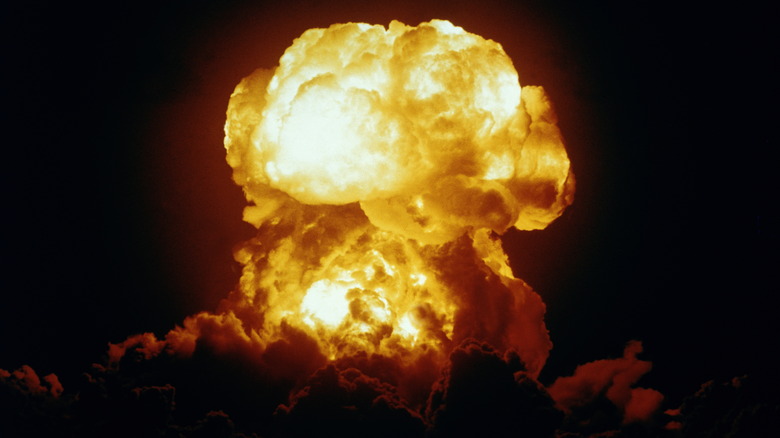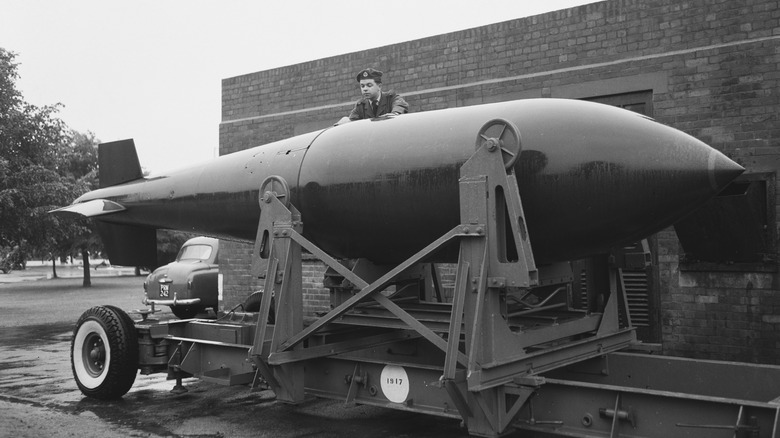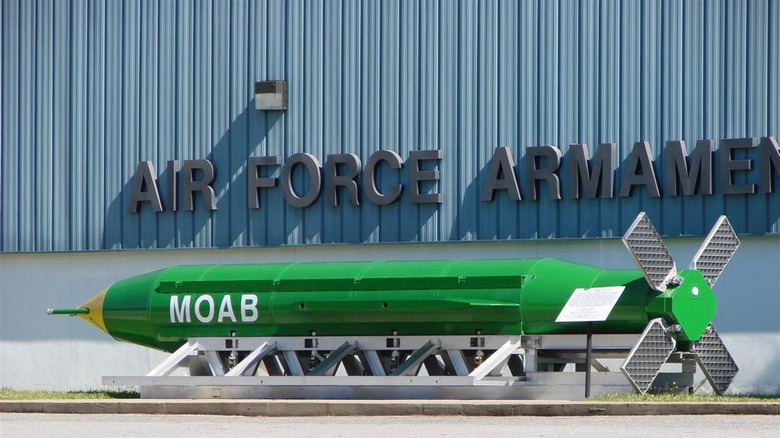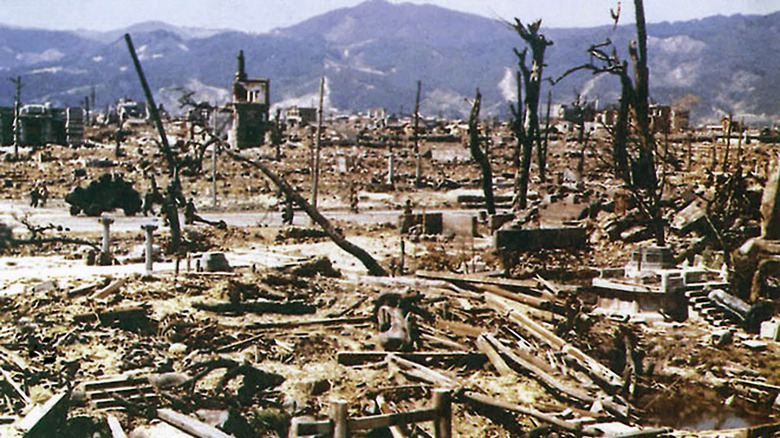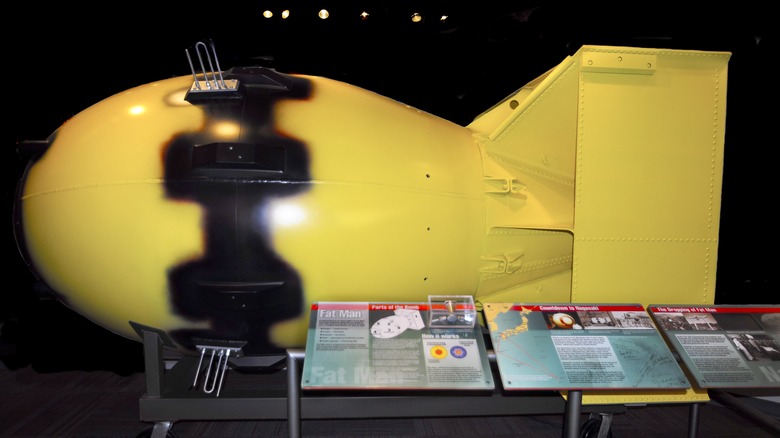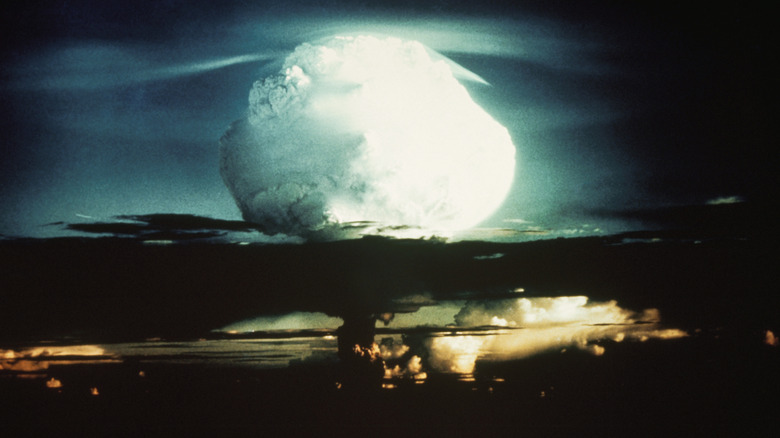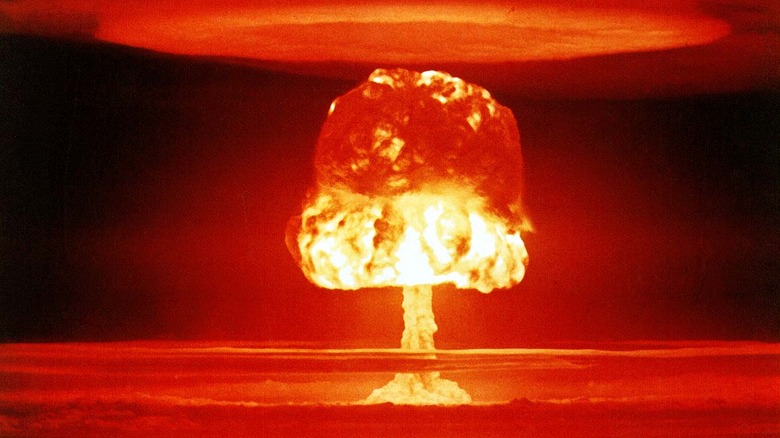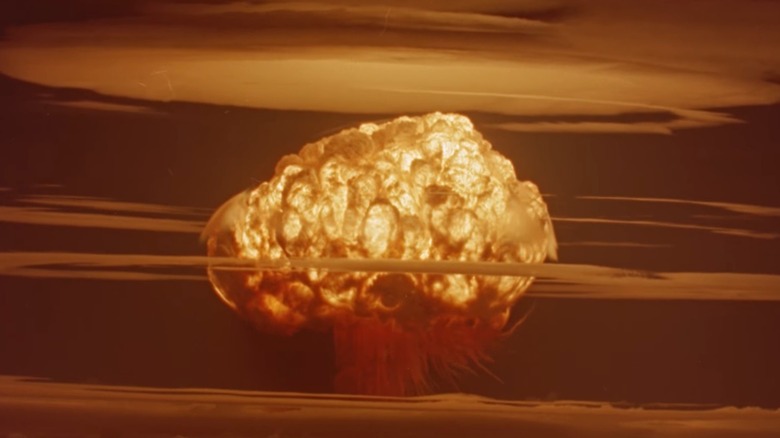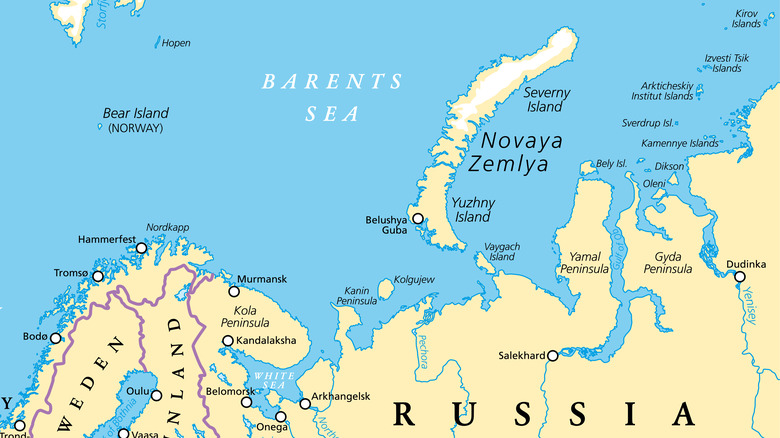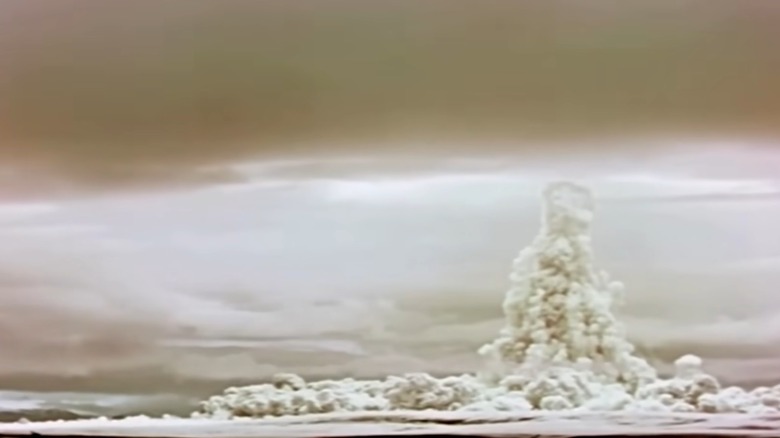The Largest Bombs Ever Detonated In World History
When the creator of the atomic bomb, Robert Oppenheimer, reflected on the terrible weapon he had created, his mind drifted to a line from the Hindu "Bhagavad Gita": "Now I am become death, destroyer of worlds." The very best minds have often been employed to create terrible instruments of destruction, especially in modern times, when powerful technology now has the capacity to wipe entire cities from the face of the earth.
Modern thermobaric devices, for example, have the ability to indiscriminately murder humans in the most brutal way imaginable, and over a vast area. These terrifying explosives are capable of creating a massive inferno by releasing a huge cloud of fuel. What's worse, even those not directly caught in the fiery blast can be horribly injured or killed by the ensuing shockwaves, which create a massive vacuum. The blast can also potentially suffocate any living beings nearby, can rupture human lungs and eardrums, and can cause severe damage to internal organs. On the other hand, the worst of the worst among modern weapons are mostly nuclear devices, whose enormous blast radiuses and terrible fallout can cause horrific death and injuries on an unthinkable scale.
Thankfully, many of the most horrifying bombs created by humanity have rarely been detonated in combat situations. The cost of using nuclear weapons in particular is usually deemed to be far too high to risk. However, even test detonations have had some disturbing consequences for those affected by unfavorable winds.
The Grand Slam Earthquake bomb
Toward the very end of WWII, the British developed the "Grand Slam" earthquake bomb, a staggeringly heavy device with terrible destructive force. Weighing in at an incredible 21,500 lbs, this bomb was first used against Nazi Germany on March 14th, 1945. It evolved from its powerful predecessor, the "Tallboy" (weighing in a bit lighter at just 12,000 lb), and sprung from the brilliant mind of engineer Barnes Wallis, the man responsible for the bouncing bombs (bombs that could skip across water deployed by specially designed Lancaster bomber planes) deployed by the famous dam-busters during a dam raid in the Ruhr Valley May 1943.
The terrible power of the earthquake bomb has often been forgotten, overshadowed by the much more powerful atomic bomb used by the Americans that same year, but it was a devastating weapon nonetheless. The force unleashed by the extremely heavy Grand Slam was capable of causing an earthquake, meaning that just one bomb could obliterate enemy infrastructure over a large area, whether or not the pilot achieved a direct hit.
For example, according to the British Royal Airforce, the British had been targeting a German viaduct over and over again and had dropped 3,500 tons of bombs on it, all to no avail. A single Grand Slam bomb could finish the job in one drop, creating a 100-foot crater and destroying 400 feet of arches in one go. More than 40 Grand Slams were used to devastate German defenses in the war's closing days.
America's MOAB — Mother of all bombs
The Massive Ordnance Air Blast, jokingly called the "mother of all bombs," or MOAB, is the biggest non-nuclear weapon ever used by the U.S. in a combat situation. The 30-foot-long device was deployed in the mountains of Afghanistan via cargo plane, in an attempt to wipe out a group of Islamic State fighters stationed there. According to Vox, in the American arsenal, only the Massive Ordnance Penetrator is bigger, a device that has yet to be used in combat.
First developed in 2003, the U.S. military initially wanted to use the MOAB as a psychological weapon to scare enemy fighters, however, it was not used until 2017, when it was dropped on a dangerous region of Afghanistan close to the Pakistan border. The area was riddled with hard-to-reach underground tunnels, rigged with explosives, that made them too dangerous to traverse by ground troops — thus providing the perfect opportunity for America to test out its mega-bomb in the field.
With an enormous blast radius of roughly one mile in diameter and exploding with the force of 11 tonnes worth of explosives, the MOAB is capable of flattening many buildings at once and is only suitable for use in specific circumstances, far from possible civilian casualties (via PBS).
China's MOAB — Mother of all bombs
In 2019, China began testing its own version of the so-called "MOAB" — or "mother of all bombs," — in an attempt to compete with similar devices developed by Russia and the United States. China's MOAB is just one of a number of bombs that the country has developed in recent years as part of the country's upscaling of its military arsenal, an attempt to reach superpower status. China's defense industry giant went so far as to release a promotional video of the enormous explosion it produced, just to show it off.
According to the Economic Times of India, it has been rumored that the Chinese bomb is thermobaric in nature; thermobaric bombs can have hideous effects on civilian bystanders, and many people believe they should be banned. However, the Chinese company NORINCO, which developed the bomb, has denied the accusation. Nonetheless, at present, it is believed that China's MOABs represent the most powerful non-nuclear weapon the country has ever developed. The device was so large — weighing in at several tonnes, and around 6 meters long (approx. 18 feet) — only a transport aircraft was able to deploy it.
The Father of all Bombs, or FOAB
Not one to be outdone for firepower, in 2007, Russia tested its very own super-weapon to rival America. The FOAB, or "father of all bombs," is Russia's answer to America's "mother of all bombs" and is four times more powerful. Today, it is quite possibly the most powerful non-nuclear bomb in existence. Reuters reports that the Russian media showed a test detonation on state television, showing images of a toppled apartment building and a scorched wasteland surrounding it.
Unfortunately for its potential targets, Russia's FOAB is not just a very big bomb — it is also the largest thermobaric weapon known to humankind. Given its scale, the deputy head of the Russian armed forces compared the impact of the FOAB to a nuclear explosion, although critics say this is an exaggeration. Despite their horrifying effects, Russia has already used smaller thermobaric devices of this kind in the Ukraine.
Little Boy
The terrifying nuclear weapon with a cutesy name, "Little Boy," was the first of the two bombs dropped on Japan in 1945. The bomb was uranium based, one of several materials used to create a nuclear reaction, and the explosion it unleashed was roughly the equivalent of 15,000 tonnes of TNT.
The ensuing blast was so massive, the pilot of the Enola Gay aircraft that dropped the bomb felt the shockwave hit the plane as he flew away, recalling: "... we turned around to take a look at it. The site that greeted our eyes was quite beyond what we had expected because we saw this cloud of boiling dust and debris below us with this tremendous mushroom on top. Beneath that was hidden the ruins of the city of Hiroshima" (via the Atomic Heritage Foundation).
It was the first time a nuclear weapon had ever been used on people, and the effects were devastating; 140,000 people living in Hiroshima were killed by the blast, and the flattened city was left to resemble a pile of burned-out matchsticks. Many residents were vaporized instantly, while others died from radiation sickness and cancer. The devastation was so enormous and so fast, it left Japan reeling. The Guardian reports that at the time, Radio Tokyo released a panicky announcement: "Medical relief agencies from neighboring districts could not distinguish-much less identify-the dead from the injured. The impact of the bomb was so terrific that practically all living things-human and animal-were literally seared to death by the tremendous heat and pressure set up by the blast."
Fat Man
Fat Man was the atomic bomb that the U.S. dropped on Nagasaki, Japan, on August 9, 1945. Three days previously, the U.S. had already destroyed Hiroshima, but America was determined to carry out a second display of strength. According to the National WWII Museum, this second plutonium-powered device had a much more complicated mechanism than its uranium-powered brother, "Little Boy." It was also quite a bit more powerful, with an explosive force equal to around 20,000 tons of TNT. The pit crew scribbled "Here's to you!" and "A second kiss for Hirohito" on the metal casing and signed their names, before they sent it off to cause massive destruction.
Originally, the bomber was supposed to drop the device on the city of Kokura, but poor weather conditions caused a last-minute change of targets. The U.S. opted to drop Fat Man right away, before conditions changed again, and so chose Nagasaki.
Although the bomb was bigger, thanks to an evacuation order fewer people died at Nagasaki than at Hiroshima — however, the death toll was still staggering. Around 40,000 people were killed in the initial deadly blast, and 100,000 people died over the next few years from the effects of radiation. The very next day, on August 10th, talk of surrender began. America had ended the war in a horrifying but efficient fashion.
Mike
Following the terrible aftermath of the atomic bombing of Japan, it was unclear whether or not research into nuclear weaponry would continue. However, inquiring minds will inevitably create instruments of mass destruction, and before long, with the blessing of President Harry Truman, U.S. scientists had begun to build the first of several "superbombs," devices that would outstrip the bombs used in the war many times over. In the lab, researchers began working with hydrogen to create new, more sophisticated devices. By 1952, scientists had created "the Mike shot," a hydrogen bomb that proved to be 1,000 times bigger than the device used at Hiroshima.
For safety's sake, the 20-foot-long device had to be triggered from a ship stationed 30 miles away (per PBS). During a period of testing code-named Operation Ivy, Mike was detonated on an atoll in the South Pacific. The test was so successful that the Island of Elugelab that the bomb was tested on was completely destroyed in the blast, engulfed in a 57,000-foot-tall fireball, with a cloud 100 miles wide. All that remains of the island today is a ring shaped-hole.
Castle Romeo and Castle Yankee
As the Cold War got hotter, the bombs got bigger, and during the years 1946 to 1958, the U.S. went through a period of intense nuclear testing. During this period, 67 hydrogen bomb tests were carried out, which included 23 on the tiny Bikini Atoll in the South Pacific Marshall Islands. Scientific American reports that the area today now has an extremely high rate of cancers (around twice the normal rate), and as of 2022, more than 60 years later, strontium levels in the islands remain freakishly high.
You may recognize the iconic image pictured above from one of these test detonations — this was the so-called Castle Romeo hydrogen bomb test, one of the biggest and most successful nuclear tests in history. According to Chuck Hansen's "U.S. Nuclear Weapons: A Secret History," the explosion was so enormous it produced a 44,000-foot-high cloud in less than a minute. The deadly ash cloud that formed on top reached an incredible sixty miles across and climbed to a staggering 110,000 feet high. The Castle Yankee Shot was similarly enormous — producing a 13.5 megaton yield that seriously damaged a plane, flying nearby to gather information, with its shockwave.
The Shrimp aka Castle Bravo
The Castle Bravo nuclear test remains the largest bomb ever detonated by the U.S. to date. Ironically, when it was built, the device was nicknamed "the shrimp," and the test team that exploded it was not expecting it to be a record-breaker.
The Shrimp was a lithium deuteride-powered "dry" bomb, and was relatively tiny compared to "wet" nuclear devices such as the "Mike Shot," which had been filled with liquid hydrogen isotopes (via Brookings). The design of the new bomb proved to be shockingly effective, exploding with a force equivalent to 15 megatons of TNT, about three times larger than expected. The terrifying explosion produced a crater that was over 6,500 feet wide.
Unfavorable winds and an unexpectedly high yield meant that any safety measures the team put in place proved to be wildly inadequate. Following the blast, the fallout stretched across 7,000 square miles, poisoning 23 fishermen stationed on a fishing boat over 80 miles away (per PBS). The radioactive ash that the bomb produced fell like snow on the people living on the nearby island of Rongelap, and many people living in the Marshall Islands were horribly afflicted by burns. Ever since the test took place, the U.S. has been handing out hundreds of millions of dollars in compensation to those afflicted by the blast. The force of the bomb was never equaled again by another American device, perhaps due to the terrible consequences that it unleashed.
Nuclear tests 174 and 219
Throughout the Cold War, the USSR tested a series of nuclear bombs on the small archipelago of Novaya Zemlya, located in the arctic circle. According to a 2005 paper published in Science and Global Security, the 536 indigenous people living in the archipelago had to be permanently removed from the area, before it was transformed into a strange nuclear wasteland. Bombs were tested in the water, above ground, and underground in the region (via NTI).
UNSCEAR, a U.N. body dedicated to the study of atomic radiation, reported that Soviet test bombs 174 and 219 were particularly enormous, outstripping the biggest American nuclear test, Castle Bravo, by an alarming margin. These bombs both produced a yield of 24.2 megatons, dwarfing the American record of just 15 megatons.
While little is known about the tests themselves, the impact they have had on the Arctic has been huge. According to Princeton University, the indigenous communities living in the arctic circle have been severely negatively affected by the fallout in the region, and the conditions created by the frosty environment have led to a slow recovery from the radiation damage. Caribou living in the Arctic (an important source of meat for local communities), for example, have become dangerously radioactive, affecting communities as far away as northern Finland.
The Tsar Bomba
The RDS-220 or "Tsar Bomba" — the "king of bombs" — was the most destructive weapon ever detonated, and by a comfortable margin. The blast was at least twice as powerful as anything before it, yielding a 50-megaton explosive force that was so gigantic it shattered windows in Finland and Norway (per The National WWII Museum).
Detonated over the Arctic in 1961, the Tsar Bomba had a complex three-stage detonation mechanism, designed to cause maximum damage. When the device was fired, the energy created by the initial atomic blast was compressed to create a second, super-massive thermonuclear explosion (per the Atomic Heritage Foundation).
The mushroom cloud that the bomb created swelled to an extraordinary height, reaching up to the stratosphere, and the heat from the blast could be felt 170 miles away. The crew who released the bomb were told that their mission was so dangerous they only had a 50% chance of survival. Thankfully, due to the great height at which the bomb was detonated and the fact that it produced more fusion than fission, the fallout from the explosion was minimized, averting a potential humanitarian catastrophe. Nonetheless, the project was seen as tantamount to insanity, and it caused an international outcry. Even the Soviets themselves seem to have realized that they had gone too far this time: The Tsar Bomba test was one of the factors that led to the signing of the Partial Nuclear Test Ban Treaty in 1963.
